#euglenophyta
Explore tagged Tumblr posts
Link
1 note
·
View note
Text
chara, podle tý se to celý jmenuje charophyta. pletivná stélka. vyskytuje se v oligotrofních vodách.


a poslední skupinou je euglenophyta. krásnoočka. takový řasy neřasy, no, moc tomu nerozumim :(
euglena je monadoidní, má stigma a hlavně paramylon. paramylon je zásobní látka krásnooček. zrna paramylonu jsou uložená v cytoplazmě. eugleny uměj docela obstojně měnit tvar.

phacus! kulatý a tlustý cosi s bičíkem.

a na úplnej konec trachelomonas. vyznačuje se tim, že má loriku.

učim se na zápočet ze sinic a řas, kerej píšu za pár hodin, avšak přemejšlim nad tim, že ještě před půl rokem jsem se musela šprtat na zpaměť stovky jmen všemožných i nemožných umělců a že šprtání se vědeckejch názvů organismů vlastně neni vo tolik jinačí. jen mě možná trochu víc baví. protože maj mnohdy roztomilý český ekvivalenty. strašně se bojim, že ten testík budu muset psát znova, protože hrozně prožívám, že sama sebe vnímám jako neznalýho idiota a bojim se taky toho, že mě ostatní vnímaj jako debila, bo jsem na střední chodila na grafku. byť si to tam nejspíš nikdo nepamatuje - proč by, že. a cejtim hroznou potřebu furt někomu - a sobě - dokazovat, že tyvole ačkoli jsem před chvilkou sotva věděla, co je buněčná stěna, tak to nakonec musí jít nějak zvládnout.
10 notes
·
View notes
Photo

Eutreptiella is a marine euglenid with chloroplasts and characteristic eyespot. Euglenids are distinguished, in part, by the ridges under the cell membrane.Scientists say that identifying species within these hard-to-see groups, where they are and in what numbers, and the environmental role of each, is critical for understanding the size, dynamics and stability of Earth's food chain, carbon cycle and other issues. Photograph: D. J. Patterson, L. Amaral-Zettler and V. Edgcomb/MBL. Marine euglenid are unique organism that are classified as Euglenophyta, neither plants or animals, though it has characteristics of both.
35 notes
·
View notes
Photo
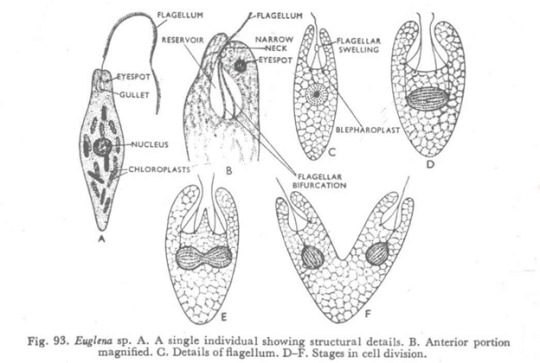
Euglenophyta character General Features and Relationships starts http://bit.ly/2HENu8h
0 notes
Text
Euglenophyta

3 notes
·
View notes
Text
300+ TOP ALGAE Objective Questions and Answers
ALGAE Multiple Choice Questions :-
1. The number of members of the division Phaeophyta that live in freshwater habitats A. is greater than the number of members of the division Chloro-phyta that live in freshwater habitats B. is lesser than the number of members of the division Chlorophyta that live in freshwater habitats C. is equal to the number of members of the division Chlorophyta that live in freshwater habitats D. none of the above 2. Which of the following is correct? A. All members of photolithotrophic autotrophs are also members of algae, but not all members of algae are members of photolithotrophic autotrophs B. All members of algae are also members of photolithotrophic autotrophs, but not all members of photolithotrophic autotrophs are members of algae C. All members of photolithotrophic autotrophs are members of algae, and all members of algae are members of photolithotrophic autotrophs D. No member of photolithotrophic autotrophs is a member of algae 3. Bioluminescence is a phenomenon associated with A. chrysophyta B. phaeophyta C. pyrrophyta D. chlorophyta 4. Which of the following algal divisions is characterized by possession of chlorophylls A and B, starch as the energy storage material, cellulosic cell walls and live in freshwater and marine habitats? A. Chlorophyta B. Chrysophyta C. Phaeophyta D. Pyrrophyta 5. Which algal division is divided up into three main groups consisting of the golden-brown algae, the yellow-green algae and the diatoms? A. Chlorophyta B. Chrysophyta C. Phaeophyta D. Pyrrophyta 6. Zooxanthellae are algal symbiont that live within coral reef animals. These algae belong to A. chlorophyta B. chrysophyta C. pyrrophyta D. rhodophyta 7. All algae possess A. nuclei B. chloroplasts C. Both (a) and (b) D. none of these 8. Algae is a nonvalid taxinomic term that refers to A. eukaryotic organisms that have chlorophyll a and produce O2 B. well developed cellular structure including a conducting system C. Both (a) and (b) D. none of the above 9. Which of the following algal divisions is characterized by possession of chlorophylls A and B, paramylon as the energy storage material, and the presence of a pellical instead of a cell wall? A. Chlorophyta B. Euglenophyta C. Pyrrophyta D. Chrysophyta 10. Laminarin is an energy storage material characteristic of A. chlorophyta B. chrysophyta C. phaeophyta D. pyrrophyta

ALGAE MCQs 11. Chlamydomonas and Volvox are similar because A. they both are motile B. they are members of the Chlorophyta C. Both (a) and (b) D. none of these 12. Characteristics used to place algae into divisions include all of the following except A. form of storage material B. flagella number and location C. accessor pigments used in photosynthesis D. all of the above 13. Which algal division never produces motile, flagellated cells among any of its members? A. Chlorophyta B. Chrysophyta C. Phaeophyta D. Rhodophyta 14. Starch is an energy storage material characteristic of A. chlorophyta B. chrysophyta C. phaeophyta D. rhodophyta 15. Number of flagella produced by motile cells in A. members of the phaeophyta is greater than members of the Oomycota B. members of the Oomycota is greater than members of the Phaeophyta C. members of the Phaeophyta is approximately equal to members of the Oomycota D. none of the above ALGAE Objective Questions with Answers 17. The number of flagella produced by motile cells in A. members of the Rhodophyta is greater than members of the Phaeophyta B. members of the Phaeophyta is greater than members of the Rhodophyta C. members of the Rhodophyta is exactly or approximately equal to members of the Phaeophyta D. none of the above 18. Algae are classified into 6 groups, technically known as A. categories B. divisions C. genera D. domains 19. The __________ is the vegetative body of algae. A. mycelium B. plasmodium C. pseudoplasmodium D. thallus 20. Agar, which is the solidifying agent in many bacterial culture media, is part of the cell wall of A. chlorophyta B. chrysophyta C. pyrrophyta D. rhodophyta 21. The kelps are algae found in A. chlorophyta B. chrysophyta C. phaeophyta D. pyrrophyta 22. Frustules made of silica are characteristic of A. euglenoids B. diatoms C. desmids D. seaweeds 23. Algae are found in all of the following places except A. oceans B. soils C. lakes and streams D. associates with fungi 24. Which of the following best describes the algae known as diatoms? A. Cells have intricate shells of silicon dioxide with two halves B. Cells are encased in rigid walls composed of cellulose coated with silicon C. Cells have flagella and a light-detecting eye spot D. Cells contain carotenoid pigments as well as chlorophyll A and B 25. Chrysolaminarin is an energy storage material characteristic of A. chlorophyta B. chrysophyta C. phaeophyta D. rhodophyta ALGAE Questions and Answers pdf Download Read the full article
0 notes
Text
Reflection on Chapter 18
After learned the chapter 18, I understood that the life cycle of representatives of principle phyla are including the Chlorophyta, the Chromophyta, the Euglenophyta, which are also explored having association with many details. Then it showed me the differences between the phyla of algae in a table which is very clear to see and followed with a digest of the human and ecological relevance of the algae. From my perspective, the similarities and differences among algal, fungal, and protozoan groups have led scientists to propose major taxonomic changes, and those changes are continuing. For me, the most interesting part is human and ecological relevance of the algae, slime molds and water molds. For algae, many parts of it have different functions. As microscopic forms that live suspended in the water column, provide the food base for most marine food chains. In my daily life, I can always see some edible algae, like kelp, wakame, seaweed, ulva and Enteromorpha, they are all from different color of algae. I remembered when I was a little kid, I saw some people just standing around the edge of the pond, then my father told me they were judging the water quality based on watercolor which is determined by the dominant species of algae and its reproductive. In the industry, it can also be used to provide a variety of algal gum, which are the raw material for medicine and chemical industry and culture for microbiology research. For slime molds and water molds, both of them with function as ecological decomposers. Slime molds can be found on bark mulch after a rain and can produce a pseudoplasmodium that crawls like a slug which is really disgusting to me since I’ve seen slug many times in my dormitory in China. Water molds can be harmful to the French wine and caused an important oomycete called late blight of potato. Otherwise, both of them are of little economic significance which are really interesting. The difficult part for me is to figure out the reproduction in diatoms and life cycle of oedogonium. The definitions of oogonia and thallus are hard to understand, and the functions of holdfast and stipe are complicated, which takes me a lot of time searching the Internet to figure out. In a word, we all live in a world which contains the Kingdom Protista. Algae, as an original and important member of this kingdom, have making movements 400 million year ago, which is a really ancient creature but with so many functions and connections with our daily life.
Reference: https://www.toppr.com/guides/evs/a-treat-for-mosquito/algae/
0 notes
Text
Study on Dynamic of Phytoplankton in the Southern Part of Caspian Sea- Juniper Publishers
Abstract
Due to various Physic and Chemical factors of rivers leading to the sea, the situation seems different topography Throughput rate initial production in the different seasons are different. During 2012 in spring, summer, autumn and winter, in a study of 8 transects of 40 stations.In each transect from Astara to the Turkmen. 5 stations at depths of 5.10.20.50.100m were selected for sampling. The total number of 182 species from seven branches Bacillariophyta, Pyrrophyta, Cyanophyta, Chlorophyta, Euglenophyta, Xantophyta and Chrysophyta phytoplankton were identified. Including 81 species of Bacillariophyta, 33 Cyanophyta, 25 Pyrrophyta, 31 Chlorophyta, 9 Euglenophyta, 1 Xantophyta and Chrysophyta had 1 specie. Our study demonstrates that across Southern Caspian Sea, varying in environmental conditions and morphology, pronounced season and temperature gradients favor the distribution of bulk phytoplankton into more defined layers and seasons, while the depth of the peak and the heterogeneity of individual phytoplankton groups were differentially affected by habitat structure.
Keywords: Phytoplankton; Caspian sea; Dynamic; Diversity; Species
Go to
Introduction
Since phytoplankton are the base of life and productivity of aquatic ecosystems, sustainable ecological study of the Caspian Sea, particularly the distribution and identification of species composition, density and biomass, seasonal and regional variations in phytoplankton before each study seems necessary [1]. Due to various circumstances physical and chemical rivers leading to the sea, seabed topography in different situation appears to be of primary production in the eastern and western between the Caspian Sea in the season, may be altered. Identifying species and determining the distribution and biomass of the changes and how they are affected by environmental changes [2] and we are environmentally conscious [3]. We also compare the current situation with previous studies; we find that the number and types of plankton biomass have been what it is. During 2012 5 stations at depths of 5. 10. 20. 50. 100 m were selected for sampling by Niskin sampler [4] (Figure 1).
Go to
Discussion
The total number of 182 species from seven branches Bacillariophyta, Pyrrophyta, Cyanophyta, Chlorophyta, Euglenophyta, Xantophyta and Chrysophyta phytoplankton were identified [5]. Including 81 species of Bacillariophyta, 33 Cyanophyta, 25 Pyrrophyta, 31Chlorophyta, 9 Euglenophyta, 1 Xantophyta and Chrysophyta had 1 specie.
Studies have shown that density and biomass of Bacillariophyta were 228 (±471) per cubic meterx106) and 6157 (±290mg per cubic meter) respectively and Pyrrophyta were 28.17 (±27.14) cubic meterxlO6 in cubic meters) and 3349 (±336mg per cubic meter) and Cyanophyta 120.40 (±123.87( per cubic meterx106 per cubic meter), biomass (55±57mg per cubic meter) were the branches of the dominant phytoplankton. Abundance and biomass in different seasons have been significant differences (p<0.05) [6,7]. Most of Bacillariophyta (61 species) was in autumn and then in winter (48 species). Dominant species of Bacillariophyta were Pseudonitzschia seriata, Rhizosolenia fragilissima, Stephanodiscos sp., Melosira varians, Nitzschia acicularis and Cyclotella menenghiniana Pyrrophyta was greatest diversity of branches in summer, autumn and winter (19 species), which includes Exuviaella cordata, Exuviaella marina, Prorocentrum praximum and Prorocentrum scutllum. In the autumn density of Cyanophyta was 285.7 (±137.1) cubic metersx106 and biomass was 95±54mg per cubic meter and 18 species were observed. The dominant species in this category were Oscillatoria sp., Nodularia spumigena and Oscillatoria agardhii [8].
Most species of Chlorophyta branche in autumn and winter and summer median region with the highest density [9] at the density of 26.2% and most of it is Binuclearia lauterbornii. Identified as the branches Euglenophyta were Trachelomonas, Euglena and Phacus that were observed in all seasons. In winter, the highest mean biomass was 9±0.818mg per cubic meter and the highest density of in summer was (0.5±0.5) in cubic metersx106. In winter the depth of 10 meters and surface of Babolsar, Amir Abad and Anzali, a kind of Chrysophyta and in surface of Tonekabon and Anzali a species of Xantophyta were observed that had negligible density and biomass.
Go to
Conclusion
The biological survey in each ecosystem has an important role that relate to the amount of aquatic source [10] there. The study of phytoplankton is essential that helps us to achieve our goal and to indicate primary production, as algae play an important role in aquatic water bodies [5]. Our study demonstrates that across Southern Caspian Sea, varying in environmental conditions and morphology, pronounced season and temperature gradients favor the distribution of bulk phytoplankton into more defined layers and seasons, while the depth of the peak and the heterogeneity of individual phytoplankton groups were differentially affected by habitat structure. Phytoplankton habitat structure was relatively different between the different seasons [11].
To Know More About Journal of Oceanography Journal Please Click on: https://juniperpublishers.com/ofoaj/index.php
To Know More About Open Access Journals Publishers Please Click on: Juniper Publishers
0 notes
Link
1 note
·
View note
Text
Algas euglenófitas
"
A classificação biológica usada por especialistas da área inclui algas euglenófitas no filo Euglenophyta e classe Euglenophyceae. As euglenófitas ou organismos euglenoides têm ampla diversidade e compreendem cerca de 1.000 espécies registradas. Estudos moleculares sugerem que os primeiros organismos fagocitavam partículas sólidas e, portanto, eram heterótrofos. Atualmente, 2/3 dos euglenoides são heterótrofos e também ingerem compostos orgânicos dissolvidos no ambiente. Apenas 1/3 dos representantes são autótrofos, ou seja, realizam fotossíntese e o mais conhecido são as euglenas (gênero: Euglena). Para tanto, possuem clorofila do tipo a e b, além de carotenoides, outro tipo de pigmento, o que sugere que os cloroplastos destas algas surgiram de uma endossimbiose com uma alga verde.
O hábito alimentar explica a preferência pelos locais que habitam. Logo, são encontradas em ambientes de água doce rico em matéria orgânica; poucas espécies forma registradas em ambientes marinhos, em água salobra e solos úmidos.
//<![CDATA[ googletag.cmd.push(function() { googletag.display('dfp-arroba-meio1'); }); //]]>
Morfologia e características gerais
Organismos euglenoides têm representantes unicelulares, flagelados e raramente coloniais. A maioria das euglenófitas não possui parede celular sobre a membrana plasmática. Assim, a sustentação da membrana celular se deve a uma película constituída por proteínas, que pode ser flexível ou rígida (figura 1) e fica abaixo da membrana. As euglenas apresentam as características típicas da maioria dos representantes e pode ser visualizada na figura 2.
Figura 1. Fotos de microscópio de Euglena (a seta aponta a película ).
Os organismos natantes possuem dois flagelos, porém apenas um é longo e observado, enquanto que o outro fica na base de outra estrutura referida por estigma ou mancha ocelar, cuja função é de um sistema fotossensível. Outra estrutura importante é o vacúolo contrátil, que tem como função eliminar o excesso de água, via osmose, do interior do organismo para o ambiente. A substância de reserva energética é o paramido, grânulos de polissacarídeos que se formam no citoplasma e são estocadas nos plastos (conhecidos também como plastídios, ou cloroplastos). Estes organismos possuem vários plastos.
//<![CDATA[ googletag.cmd.push(function() { googletag.display('dfp-arroba-meio2'); }); //]]>
As euglenófitas se assemelham muito a outras algas, principalmente as algas verdes, pois além do tipo de clorofila, os plastos apresentam uma região rica em proteína conhecida como pirenoide, que armazena a rubisco, principal enzima da fotossíntese.
Ciclo de vida
O tipo de reprodução registrado para as euglenófitas é assexuado e ocorre por divisão binária (ou citocinese longitudinal), quando algas unicelulares dividem-se por mitose originando novas algas (como um clone). Diferente de outros protistas, plantas, animais e fungos, estas algas mantém o envelope nuclear intacto durante a mitose. A reprodução sexuada é desconhecida ao grupo.
Figura 2. Estrutura básica das euglenófitas. Ilustração: snapgalleria / Shutterstock.com [adaptado]
Bibliografia recomendada:
http://tolweb.org/Eukaryotes/3 (consultado em julho de 2018)
http://tolweb.org/Euglenozoa/2405 (consultado em julho de 2018)
Bicudo, C.E.M. & Menezes, M. (orgs.) 2006. Gênero de Algas Continentais do Brasil (chave para identificação e descrições). Ed. Rima, 2ª. edição, São Carlos, SP. 502p.
Evert, R.F. & Eichhirn, S.E. 2014. Raven/ Biologia Vegetal. 8ª edição, Guanabara Koogan, Rio de Janeiro, pp.278-316
Fidalgo, O. & Fidalgo, M.E.P.K. 1967. Dicionário Micológico. Rickia – Série Criptogâmica dos “Arquivos de Botânica do Estado de São Paulo”. Instituto de Botânica, São Paulo. 232pp.
Judd, W.S., Campbell, C.S., Stevens, P.F. & Donoghue, M.J. 2009. Sistemática vegetal: um enfoque filogenético. Artmed, 3ª. edição, Porto Alegre, RS. 632p.
Lee, R.E. 2008. Phycology. 4ª edição, Cambridge University Press, New York. 561pp.
The post Algas euglenófitas appeared first on InfoEscola.
InfoEscola https://ift.tt/2x6YKT3 Publicado primeiro em https://www.infoescola.com"
Este conteúdo apareceu primeiro em: https://ift.tt/2w0BWWY
0 notes
Text
Algae - Introduction and Classification
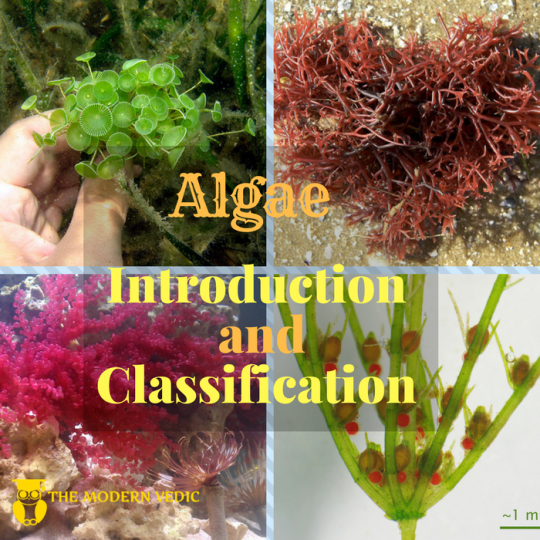

Gelatinous red alga on the coral reef The land plants evolved from algae about 500 million years ago. Algae is distinguished from other plants by the lack of true roots, stems or leaves. The terrestrial plants have specialized cells for absorbing and moving nutrients and for reproduction. Algae are thus simple plants that range from microscopic microalgae (Diatoms) to macroscopic algae (Kelp). They are very diverse and found every where on planet. Algae are aquatic photosynthetic organisms containing cells with unique features, not found among plants or animals.There are a large number of algae found across the world. Scientists have been doing research from a long time,to identify the types of algae found across the world.Many types have been discovered but still many are left to be discovered. Basic Characteristics of Algae Algae has the ability to perform photosynthesis with the production of molecular oxygen, which is associated with the presence of chlorophyll a, b or c They do not have specialized transport tissues or organs consisting of interconnected cells that move nutrients and metabolites among different sites within the organism Algae Reproduce sexually or asexually to produce gametes that are generally not surrounded by protective multi-cellular parental tissues. Classification of Algae The major algal groups are distinguished on the basis of : Pigmentation and Photosynthetic apparatus Products stored Flagella characteristics Method of propagation Cell wall composition Nuclear organization Pigmentation and Photosynthetic Apparatus
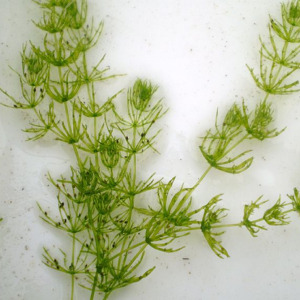
Green algae Chara The pigments used in the photosynthetic apparatus of algae help in separating algae on the basis of their color. Algae has three basic pigments : Chlorophylls : The types of chlorophyll present in algae are chlorophyll a, b, c, d and e. Chlorophyll-a is present in all classes of algae. Carotenoids : Algae contains two kinds of carotenoids which are xanthophylls (20 types) and carotenes (4 types). Biloproteins : These are water soluble pigments of algae (phycocyanin, phycoerythrin and allophycocyanin). Chloroplasts of algae have an arrangement of stacks in their granum called thylakoids which contain these pigments and are known as photosynthetic apparatuses. Products Stored All algae groups have the same photosynthetic primary products but the nature of insoluble reserved foods may differ due to the life span of the algae. Starch is often considered for the distinction of different groups of algae. Flagella Characteristics

Chlamydomonas reinhardtii : Single Cell Green Algae with Long Flagella Classes of algae can be separated on the basis of type, number and position of flagella. Though the basic flagellar structure is similar (9+2 - component fibrils pattern) but sometimes it is completely absent. Method of Propagation The method of propagation which is sexual leads to isogamy, anisogammy and oogamy or asexual results in different life cycles of algae. Haplontic Life Cycle Diplontic Life Cycle Triphasic Life Cycle

The presence or absence of sexual reproduction, complexity of reproductive organs, method of sexual reproduction becomes an important criteria of algal classification.

Single cell algae with cell wall made up of silica : Diatom Cell Wall Composition The cell wall in algae is generally made up of poly-saccharides. In some cases lipids and proteins are also present in them. The inner layer of cell wall in algae is generally made up of cellulose, which is an insoluble poly-saccharide. The outer layer of algae is generally made up of pectic substances. In some algae, the cell walls are calcified or silicified, while some algae have alginic acid or fucinic acid in the cell wall instead of cellulose. Nuclear Organization

Acetabularia On the basis of nuclear organization, algae can be prokaryotic or eukaryotic. DNA fibrils are free in nucleoplasm and are not associated with any Histones. Cell division by mitosis and meiosis is not found. If the membrane bound cell organelles like chloroplast, mitochondria and ER are absent then the algae is prokaryotic. Eukaryotic algae have a well differentiated nucleus, mitochondria, chloroplast and endoplasmic reticulum in their cell structure. Types of Algae The size range of algae varies, and forms the basis of division in groups including the basic cellular characteristics. Many types of algae consist of only one cell, while the largest of algae has millions of cells. In a large, macroscopic algae, groups of cells are specialized for specific functions, such as anchorage, transport, photosynthesis, and reproduction. Such specialization indicates a measure of complexity and evolutionary advancement. Blue-green algae (Cynobacteria)

Crystal structure of Cynobacteri The Cynobacteria are also referred to as blue-green algae because they are capable of conducting oxygen-producing photosynthesis and live in the same environments as eukaryotic algae. The cyanobacteria are gram-negative bacteria, and therefore are prokaryotes. They are also capable of independently conducting nitrogen fixation viz. the process of converting atmospheric nitrogen to usable forms of the element such as ammonia. The prefix "cyano" in cynobacteria means blue because the bacteria has pigments that absorb specific wavelengths of light and give them their characteristic colors. Many cyanobacteria have the blue pigment phycocyanin, a light-harvesting pigment (it absorbs red wavelengths of light). All Cyanobacteria have some or the other form of the green pigment chlorophyll, which is responsible for harvesting light energy during the photosynthetic process. Some also have the red pigment phycoerythrin, which absorbs light with the green region and gives the bacteria its characteristic pink or red color. Euglenoids (Euglenophyta)

Euglena garcilis under microscope The euglenoids, or Euglenophyta, are single-celled, protozoan-like algae, mostly found in freshwater. Most euglenoids make their own food using light energy from the Sun but are capable of surviving in the dark if they are fed with organic materials. Some species are heterotrophic, meaning they do not produce their own food but feed on organic matter suspended in water. At the anterior end of the cell there is a gullet, through which one, two, or sometimes more flagella extend themselves. The contracting vacuoles and stigma are located on the sides of the gullet but in creeping forms the flagellum is rudimentary. They reproduce by means of longitudinal splitting and under unfavorable conditions, some species discard their flagella and form protective spores (cysts). Golden-brown algae (Chrysophyta)

Diatoms with silica cell wall The Chrysophyta, or golden-brown algae and diatoms, are named because of the yellow pigments that they possess. These are single-celled algae which can live both in freshwater as well as salt water. The cell walls of chrysophyta have no cellulose but are composed mostly of pectin, which is often filled with silica, a compound that makes the walls of this algae quite rigid. These algae store energy both as a carbohydrate and as large oil droplets. Diatoms have two glass shells made largely of silica that fit together like a pillbox and are exquisitely marked. Their species live in groups of 40,000 to 100,000 algae. When they die, their shells help to form sediments on the sea bottom. This fine-grained sediment is often used for filtration in liquid purification systems. Fire algae (Pyrrophyta)

Dinoflagellates Pyrrophyta are mostly unicellular microorganic Protists divided by botanists in two phyla, dinoflagellates and criptomonads. Fire algae, or Pyrrophyta, are single-celled algae and include the dinoflagellates which have two flagella used for locomotion. Most of these microscopic species live in salt water, with some occurring in freshwater. Some species of dinoflagellates emit bright flashes of light when exposed to air, which at night look like fire on the ocean's surface Green algae (Chlorophyta)

Sea lettuce The green algae, or Chlorophyta, occur in freshwater, although some live in the sea as well. Most green algae are single-celled and microscopic in nature, forming the slimy green scum often found in stagnant ponds. Others are larger and more complex, forming spherical (round) colonies composed of many cells or as straight or branched filaments (long, thin series of cells). Green algae is believed to be in the evolutionary line, that gave rise to the first land plants of the planet earth. More than 6,500 species of green algae are classified as Chlorophyta and most of them live in the ocean, while there are around 5,000 species that live in the freshwater lakes and ponds. Red algae (Rhodophyta)

Dragon tongue Red algae The red algae, or Rhodophyta, are marine plants that live mainly in shallow waters and deep tropical seas. A few types of red algae are found in freshwater as well. Their body has a range of single-celled as well as branched filaments. The larger species have filaments that are massed together and resemble the leaves and stems of plants. They have no flagella and typically grow on a hard surface or on other algae. Some species contain a red pigment also. The cell walls of Coralline red algae are heavily encrusted with minerals and help to cement and stabilize coral reefs. Brown algae (Phaeophyta)
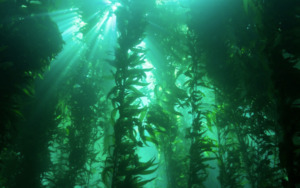
Kelp forest The brown algae also known as Phaeophyta, are shiny brown seaweeds which are found along rocky coasts. Brown algae are large in size and include the giant kelps, which are located along the Pacific coast and often form forests, that provide habitat to a wide range of marine life. Some species of brown algae have structures called holdfasts that anchor the algae to submerged rocks. Attached to the holdfasts are stemlike stalks that support wide leaflike blades of algae. These blades provide the major surface for nutrient exchange and photosynthesis and are lifted up toward the water's surface by air bladders. Brown algae contain an accessory brown-colored pigment that gives the plants their characteristic dark color. Other well-known brown algae are the common rockweed Fucus and Sargassum, which floats in a thick, tangled mass through the Sargasso Sea(a huge area of slow currents in the mid-Atlantic Ocean that supports a variety of marine organisms) Yellow-green algae (Xanthophyta)

Xanthophyta The yellow-green algae, or Xanthophyta, primarily occur in freshwater lakes or ponds. They can be either single celled or form colonies. Their cell walls are made up of cellulose and pectin compounds that sometime contain silica. They can have two or more flagella for locomotion, and they store their energy as carbohydrates. They derive their yellow-green color from the pigments carotenoids and xanthrophyll. Read the full article
0 notes
Photo
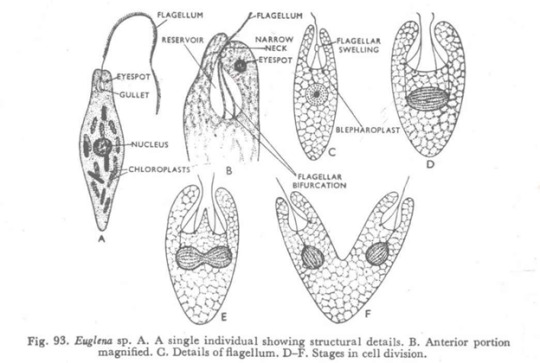
Euglenophyta character General Features and Relationships starts http://bit.ly/2HENu8h
0 notes
Text
Protoctistas
Características:
Eucariotos
Autótrofos ou heterótrofos
Uni ou multicelulares (também formam colônias)
Reino polifilético, ou seja diferente origem reprodutiva
*Para o estudo dividiremos em protozoários e algas*
Protozoários
Características:
Unicelulares
Heterotróficos
Vida livre, parasitas ou simbiontes
Classificação (de acordo com características da célula e estruturas de locomoção)
Apresentam estrutura locomotora
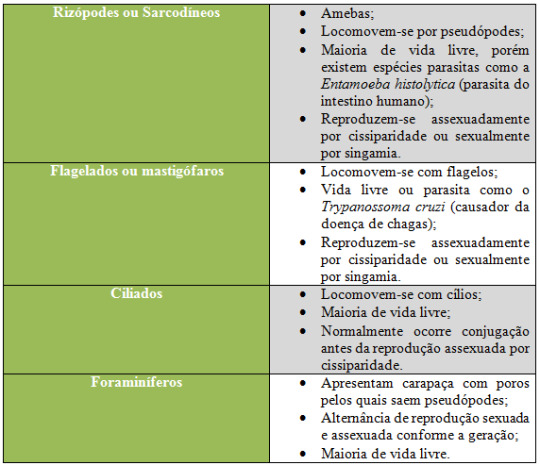
Ausência de estrutura locomotora

Morfologia e Locomoção
* Pseudópodes: Expansões temporárias do citoplasma para locomoção ou alimentação;

*Flagelos: filamentos longos que produzem movimento ondulatório;

*Cílios: Cobrem toda a superfície da membrana, se movimentam em conjunto;

Reprodução
Sexuada: singamia.
Assexuada: cissiparidade, brotamento ou divisão múltipla.
Algas
Classificação (conforme conjunto de pigmento e no tipo de substância de reserva)
-Filo Chlorophyta: incluem cerca de 17000 espécies de algas com coloração verde, que podem ser encontradas em diversos ambientes como água doce, salgada e ambiente terrestre. São encontradas também em associação mutualísticas com fungos, formando os líquens. Apresentam representantes unicelulares e pluricelulares. A maioria é microscópica, mas elas possuem representantes com grandes tamanhos. Esse é o caso da Codium magnum que atinge mais de 8 metros de comprimento. Acredita-se que as plantas evoluíram a partir desse grupo de algas em razão de características como: presença de clorofila a e b, além de amido como substância de reserva;
- Filo Phaeophyta: incluem cerca de 1500 espécies de algas de coloração parda. É o grupo com as maiores e mais complexas algas. Possuem apenas espécies marinhas. Seu corpo é bem diferenciado, lembrando caules e folhas. Possuem tecidos condutores que lembram os das plantas. Não são comuns nos trópicos, mas, neste ambiente, destaca-se a espécies do gênero Sargassum;
- Filo Rhodophyta: incluem cerca de 6000 espécies de algas de coloração avermelhada em virtude da presença de ficobilina. Essas algas vivem em ambientes marinhos, água doce e em locais úmidos. Possuem poucos representantes unicelulares;
- Filo Bacillariophyta: incluem cerca de 100000 espécies. Também são chamadas de diatomáceas. São algas unicelulares ou coloniais que vivem em ambientes aquáticos. Possuem por característica principal a presença de paredes de sílica divididas em duas partes que se encaixam de forma semelhante a uma placa de Petri. Essa carapaça é denominada frústula;
- Filo Chrysophyta: incluem cerca de 1000 espécies com coloração dourada e também organismos incolores. A cor dourada é resultado do pigmento fucoxantina. São unicelulares, mas também podem formar colônias. Vivem em ambientes aquáticos. O carboidrato de reserva é a crisolaminarina, assim como as diatomáceas;
- Filo Euglenophyta: incluem cerca de 900 espécies. São protistas flagelados, que vivem normalmente em água doce. Os representantes desse filo apresentam um flagelo maior e um menor que não chega a emergir da célula. São unicelulares, com apenas um gênero colonial. Alguns representantes alimentam-se de partículas orgânicas retiradas do meio, sendo, portanto, heterotróficos. Possuem paramido como substância de reserva;
- Filo Dinophyta: incluem cerca de 4000 espécies. Ocorrem em ambientes marinhos e água doce. São organismos unicelulares com dois flagelos. Um dos flagelos forma uma espécie de cinto, enquanto o outro é perpendicular a esse. Essa disposição dos flagelos faz com que o dinoflagelado se locomova rodopiando. Algumas espécies possuem uma placa de celulose formando uma espécie de armadura. Alguns dinoflagelados são responsáveis pela maré vermelha. Existe ainda uma espécie (Noctiluca sp) que apresenta bioluminescência.
Referências
Livro didático
material fornecido pelo prof Paim
http://www.sobiologia.com.br/conteudos/Reinos/bioprotista2.php
http://biologianet.uol.com.br/botanica/algas.htm
0 notes
Text
ALGAS
Antiguamente las algas formaban una categoría taxonómica denominada Algae (Algas) dentro de la División Tallophyta. Esta última división hace referencia a organismos donde no se diferencian raíz, tallo y hojas. Sin embargo la denominación algas persiste en la actualidad, no como categoría taxonómica, sino como una expresión generalizada aplicada a un conjunto funcional de organismos que ocupan un ecosistema acuático.
El término algas se aplica a un grupo heterogéneo de organismos no relacionados taxonómicamente. Comprenden organismos microscópico o macroscópicos con representantes procariotas y eucariotas e incluyen una gran gama de niveles de organización abarcando desde formas unicelulares hasta talos compuestos por verdaderos tejidos (Margalef, 1981; Wetzel 1983). Con respecto a su tamaño, poseen representantes desde varios micrómetros hasta más de veinte metros en las algas del orden Laminariales (algas pardas).
Como organismos autotróficos constituyen los principales responsables de la captación de la energía lumínica en los ecosistemas acuáticos y de la productividad primaria que genera la materia orgáni ca disponible para los consumidores.
Estudios recientes en microscopia electrónica, bioquímica, biología reproductiva y molecular, han revelado que las algas están compues tas por varios grupos de organismos que pertenecen a líneas evolutivas distintas, existiendo en este grupo de organismos heterogéneos una característica importante que los relaciona bien con el grupo de las plantas: son autótrofos. Están integradas por formas pigmentadas (fotosintéticas) y apigmentadas.
Teniendo en cuenta los 6 reinos se las ubica dentro de 4: Monera (algas verdeazules, Proclorofitos), Protozoa (euglenoides y dinoflagelados), Chromista (algas pardas, doradas, amarillas, y criptófitos) y Plantae (verdes y rojas)
CLASIFICACION ACTUAL DE LAS ALGAS
Existen varios sistemas alternativos que se diferencian primordialmente en la división de los organismos a nivel de rangos taxonómicos superiores: Dominio, Reino, División.
Reinos
Bacteria: las bacterias agrupan a muchos organismos patógenos que causan enfermedades en humanos y en otros animales, así como también las algas verde azules o aquellas que se incluyen dentro de la división Cyanophyta (Cyanobacteria) y a las proclorofitas dentro de la División Prochlorophyta. El reino Bacteria, también llamado Monera, incluye a las arqueobacterias, organismos que viven en condiciones extremas como en el estómago e intestino de los mamíferos, aguas termales, medios alcalinos o ácidos, pero ninguno d e ellos forma parte de un grupo algal propiamente dicho.
Los 5 reinos restantes son eucariotas (Protozoa, Chromista, Plantae, Fungi
Algas
Protozoa: agrupan una gran diversidad de organismos flagelados y ciliados incluyendo dos grandes grupos algales: las euglenófitas (División Euglenophyta) y los dinoflagelados (División Dinophyta).
Chromista: son también un grupo variado e incluyen a algas pardas que son en su mayoría macroscópicas y marinas (Phaeophyceae) y a las algas doradas que agrupan a su vez a varias clases entre las que se destacan las diatomeas (Bacillariophyceae), algas amarillas (Xanthophyceae), criptófitas (Cryptophyceae), crisófitos (Chrysophyceae).
Plantae: las plantas incluyen además de las embriófitas (briófitos, pteridófitos, espermatófitos), a las algas rojas y verdes (Divisiones Rhodophyta y Chlorophyta respectivamente). Las algas rojas son en su mayoría macroscópicas y marinas y solo algunas viven en agua dulce (Audouinella sp., Compsopogon sp.). Las algas verdes son principalmente microscópicas y dulceacuícolas, aunque hay varios subgrupos macroscópicos que se desarrollan en ambientes marinos.
CARACTERES GENERALES DE LAS ALGAS EUCARIOTAS
Son primariamente fotoautótrofas.
La mayoría posee pared celular compuesta por polisacáridos o proteínas.
Son principalmente acuáticas, aunque algunas son t errestres, pudiendo estar adheridas a diversos substratos (rocas, plantas y animales).
Su color varia, verdes (carófitas, clorófitas), rojas, amarillas, café. Debiéndose el color de las tres últimas a la presencia de los pigmentos accesorios (carotenos y xantofilas) que le dan ese color que las caracteriza y les permite captar la luz solar a distintas profundidades.
Los zigotos no se desarrollan jamás para dar embri ones pluricelulares dentro del órgano sexual femenino.
En la mayoría de los grupos las células reproductoras son flageladas (gametas, esporas).
DIVERSIDAD MORFOLOGICA DENTRO DE LAS ALGAS
El cuerpo vegetativo de las algas se conoce como Talo y este presenta gran diversidad morfológica dependiendo del grupo algal e inclusive un solo grupo puede contener organismos de morfología completamente distinta. Por lo tanto la complejidad morfológica no es necesariamente indicativa de la posición taxonómica ni de las relaciones de parentesco de determinado grupo de algas.
El talo algal varia desde unicelular hasta multicelular y a su vez cada tipo posee una serie de variaciones que resultan de los distintos modos de adaptación de las adaptación de las algas al medio en el que viven.
Nivel unicelular: algas libres o fijas a un substrato.
Unicelulares móviles o flagelados : algas unicelulares, flageladas, generalmente con manchas oculares o vacuolas contrá ctiles. Ej. Euglena sp. (Euglenophyta)
Capsales: se inicia una formación de pared en forma de masas gelatinosas. Ej. Hydrurus sp. Tomado de http://diatom.huxley.wwu.edu/algae_images/Golden_Algae/Hydrurus

Cocales: unicelulares inmóviles, carentes de flagelos, poseen pared celular rígida. Ej. Pinnularia sp.Tomado de http://www.djibnet.com/photo/microscopio/pinnularia-dactylus-y-pleurotaenium-el-encuentro-3470855537.html
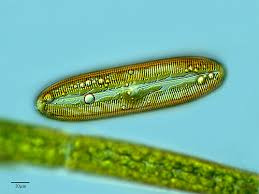
Nivel Colonial
Colonias unigeneracionales o cenobios: todas las células tienen la misma función. Ej. Pandorina sp.
Colonias multigeneracionales o verdaderas colonias: las células presentan diferenciación de funciones vegetativas y reproductivas. Ej.Volvox sp(tomado de https://volvoxcircle.wordpress.com/)
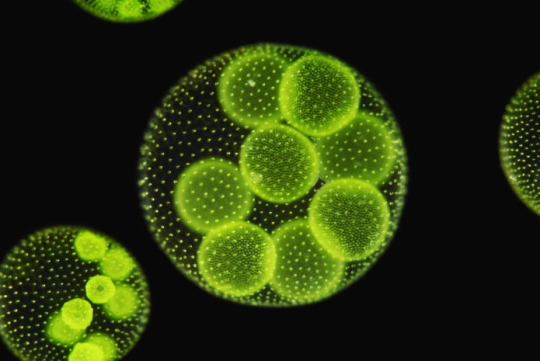
Nivel Multicelular: contienen agrupaciones de células que pueden o no depender una de otras para la subsistencia. Dentro de este tipo se encuentran los niveles:
Trical: las células uninucleadas forman filamentos simples o ramificados que crecen de modo intercalar o con células apicales. Ej. Ulothrix sp.(tomado de http://www.plantasyhongos.es/algas/Ulothricales.htm)
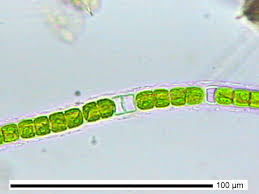
Sifonal: filamentos en los cuales se dividen los núcleos si n que se formen pared o septo entre ellos (cariocinesis sin citocinesis) dando individuos multinucleados, es decir con numerosos núcleos cont enidos en una única pared que los separa del medio externo. Ej. Derbesia sp.(tomado de http://www.thereeftank.com/mabma/genus_derbesia.html )
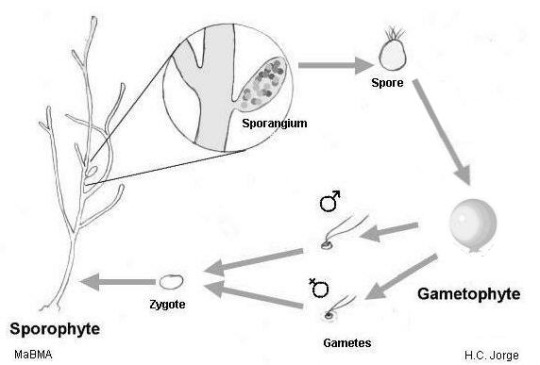
Talo plectenquimatico: las ramas laterales o filamentos se aglomeran o entremezclan; las células a menudo están conectadas entre si o incluso se adhieren unas a otras. Ej. Rhodophyta.
Talo parenquimatico: las selulas se dividen de modo multiserial quedando unidas formando un tejido compacto. Ej. Dictyota sp.
Hábitat
Las algas son fundamentalmente acuáticas, pudiendo vivir en aguas dulces, salobres o saladas. Algunas pueden tolerar distintos grados de salinidad; otras están restringidas al agua dulce. Las algas también pueden ocupar otros hábitats: como el suelo o sobre las rocas, corteza de árboles e incluso la nieve. Cierto número de especies vive simbióticamente con algunos hongos constituyendo los líquenes, mientras que otras son simbióticas de animales como corales y esponjas.
Adaptaciones
Las algas además presentan adaptaciones morfocitológicas de acuerdo al compartimiento en el que viven, lo que determina la formación de diferentes grupos funcionales algales. Cadima (2001), en un resumen de las adaptaciones de las algas presenta dos tipos de vida, comunes entre las algas:
Algas bentónicas : se desarrollan sobre substratos.
Algas planctónicas : presentes en la columna de agua.
Reproducción y Ciclos vitales
La reproducción algal varía según los distintos grupos. De manera muy general, existen dos tipos de reproducción: asexual y sexual, en esta última participan gametos o células especializadas para la reproducción.
Si bien existen grupos que se reproducen solo asexualmente (Cyanobacteria o algas verde-azules), la mayoría de las algas eucariontes alternan la reproducción sexual y la asexual a lo largo de su ciclo vital.
Las modalidades de reproducción asexual son variadas y van desde la simple división mitótica, hasta procesos de fragmentacióndel talo originando un individuo parecido al original y con la misma información genética. En algunos casos la reproducción asexual se efectúa por varias divisiones mitóticas que generan numerosas células más pequeñas que la original y que pueden o no poseer flagelos. Las células que se producen de esta manera se llaman esporas y en el caso de tener flagelos se llaman zoósporas. En la Figura 1 se resumen los cuatro tipos básicos de ciclos vitales presentes en las al gas.
Las modalidades de reproducción sexual son mucho más complejas. De acuerdo a la morfología de los gametos y dependiendo de si estos poseen o no flagelos, se reconocen cuatro tipos de reproducción en las algas. La isogamia, cuando los dos gametos (masculino y femenino) son iguales y ambos poseen flagelos. La heterogamia o anisogamia, cuando ambos gametos son flagelados, pero uno es más grande que el otro. La oogamia, cuando uno de los gametos (generalmente el femenino) es más grande y no posee flagelos y un cuarto tipo, que es una variación de la oogamia, en la que el gameto masculino también ha perdido la motilidad y es además mucho más pequeño que el game to femenino.
Tomado de http://exa.unne.edu.ar/carreras/docs/estudio%20ALGAS.pdf
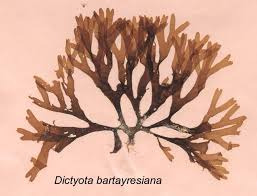
estudio de las algas , diversidad vegetal
0 notes
Photo


Trachelomonas (phylum Euglenophyta, claasis Euglenophyceae, ordo Euglenales)
5 notes
·
View notes
Link
1 note
·
View note